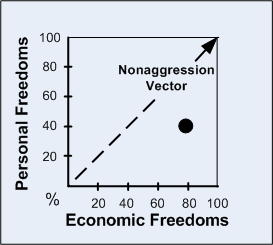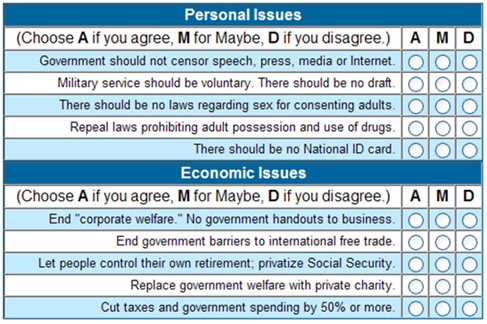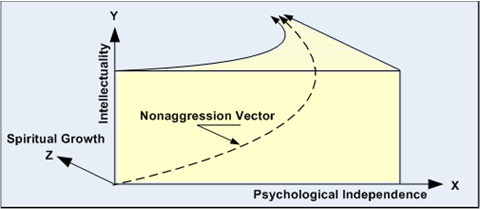SNaP Ch. 2: Nonaggression 101
Second chapter for second edition of the
Sacred Nonaggression Principle
A continuation from last week's column. I have not given up on the SNaP; in fact I'm more convinced than ever it represents the spiritual salvation of the species. Please help me make the best case possible by commenting on this column by sending me an email or subscribing and commenting to the Coffee Coaster blog. Thank you.
— Brian Wright
Nonaggression 101:
Foundations of a society of liberty, not utopia
Summary
In Chapter 1 we discussed the Kindergarten Rules, providing an intuitive basis for how we might organize an adult system. In this chapter we make arguments for adult societies based on the nonaggression principle.

An astute reader will note that a society in which the nonaggression principle is practiced is the same as a society in which liberty exists—where you are free to do as you wish… provided you extend the same courtesy to others.
Indeed, the nonaggression principle is a more mechanical and exact-descriptive phrase for liberty: a system in which you are free to go about your business[1] without being hit, stolen from, or defrauded… by any entity—not the kids in the classroom, not the kindergarten teacher, not your adult neighbors, not your adult neighbors’ government(s). Imagine that, John Lennon!
The PANG Theory
Readers will note that I haven’t done any point-counterpoint, in which I consider objections to the Kindergarten Rules or to the nonaggression principle (NaP)… for two main reasons:
- Most objections to the NaP actually amount to ignorance of the nature of aggression—which I address in Chapter 5—or to a confession that the objector desires to aggress or to tolerate aggression in certain socially acceptable areas.
- As a statement of principle, the NaP is a self-evident quality of every normal human being’s ideal society. What psychologically healthy human does not wish to live in a system without being assaulted, robbed, or defrauded?
Thus, the only true objections one hears put forward to the simple NaP—later, we will consider arguments against my sanctifying the nonaggression principle—have to do with human adequacy: that is, that people are too immoral or too stupid to realize such an ideal. Other libertarian writers, notably David Bergland in Libertarianism in One Lesson, call this whole range of objections—effectively these are the only objections to the NaP—the People are No Good (PANG) Theory.
The drill usually goes something like:
“What you’re proposing is an impossible ideal. The average man uses every opportunity to dump on his neighbor and take his stuff. If it weren’t for, say, churches and powerful government (coercion), we’d have riots in the streets. The best you can hope for is majority vote, a big government with a big club to restrain the masses, possibly with some crumbs of kindness shown toward the powerless.”
There will be some variations, but virtually all such PANG objections entail the following self-refuting qualities:
- The stolen concept: the NaP is their premise of why we need government… to protect us from aggression. Thus, they assert the NaP in an attempt to deny it.
- Virtually everyone making the PANG argument lives in a world in which 99% of everyone’s transactions are wholly NaP-based… with no police power deployed.
- If the world consisted of Mad Max post-apocalyptic packs of NaP-less savages—hence headed toward oblivion—wouldn’t that validate the NaP, not disprove it?
- Rand stated that the evaluation of something as practical (or impractical) depends on what one wishes to practice: “So, PANGer, how do you wish to aggress?”
That’s about all we need to point out about any practical objections to the NaP. Even if people are no good—and we know that, in our own society, 90-99 out of 100 people practice the NaP 24/7 without being forced to do so—the nonaggression principle is still their best option.
Besides the PANG Theory, most objections to the NaP hold out for government exemption, i.e. “If the government does it, it isn’t aggression.”[2] We’ll dispense with such childish antiquities in the course of the narration, especially when we consider the four horsemen of the NaP:
- No compulsion
- No prohibition
- No privilege
- No exceptions
For the time being, let’s continue with the simple closed-form proof of the NaP on the level of conceptual logic. Then I’ll proceed to the ‘sacred’ quality of the NaP and why that beckons us toward enlightenment… and moral action. The chapter ends with some mapping ideas for “where we are” that additionally imply “where we want to go” in terms of the NaP. I also introduce the concept of the Nonaggression Vector (NV).
Beyond the Kindergarten Rules…
So have I proven the Kindergarten Rules? Yes… as well as one may be said to prove any normative[3] concept. No one can reasonably doubt that to the extent a group of children in a kindergarten environment practice “don’t hit, don’t steal, and don’t lie” they will inhabit the best of all possible social worlds.

One objection that did come back to me on the KRs was, “Well, you have a teacher there, mainly, who enforces whatever rules she wants.” Right, so how does that alter the validity of Premise #1? A good teacher simply enforces the KRs, a bad teacher looks the other way upon acts of aggression, and may indulge aggression of her own [like my aforementioned fifth grade teacher, Mr. Meathead-Psycho.]
Otherwise, I think we’re set for smooth logical sailing in identifying the best principles for the rugrat set.
Then, we grow up. [Let’s forget that from K thru 12 most of us have been obliged by the state to be herded into government schools, that is, a compulsory system. It really doesn’t change the fact that the nonaggression principle (as expressed in the KR principle) should apply at the end of our period of state incarceration and indoctrination.]
For the same reasons the Kindergarten Rules give us the ideal small-person social system, the nonaggression principle (liberty)—that no one may rightfully initiate force or fraud upon another —gives us the ideal all-person social system.

Let me provide some small argument—from results—to support the equally self-evident Premise #2: Just as we see that children flourish in an environment free of bullies and thieves, so adults thrive best when they fear not the gun, the whip, the robber… or the con artist. To live in a world free from aggression is the human ideal because such a place best enables each individual to flourish… as she/he defines it.
Usually, people want to be productive and safe, develop an idea or a business for their families, move forward in knowledge and capability in the real world. They plan and save, work and trade, socialize and enjoy the fruits of their labor.
But some people may not care for that mode of life. Some even may engage in self-destructive, addictive behavior. Absent aggressive harm to others, these self-destructors must be left alone; they own their own persons, they do not belong to you. By definition, the self-destructive tend to destroy themselves, thus creating higher percentages of the nondestructive. The best thing for “society” is to leave such individuals alone.
Please refer back to the section under the Core Values heading in Chapter 1, which belongs here as well. By adopting the nonaggression principle, by holding it as one of the highest ideals for your society, you support all the core values commonly associated with civil society, particularly American society. To repeat, here are some of the subordinate yet foundational values that the NaP value enables:
- Rule of law
- Equality of rights
- Life, liberty, and property
- Popular (i.e. individual) sovereignty
- Separation of powers
- Sanctity of family
- Home as a castle
- Justice is impartial
- No legal privileges
- Respect for (valid) authority
- Honoring our (wise, moral) elders
And so on. Thus, we may consider Premise #2, which is the simple nonaggression principle, demonstrated. Now we may proceed to the heartfelt conclusion that invigorates[4] my book: the simple NaP is the highest moral ideal in social systems—sacred.

Okay, now we can all go home.
Well, not quite. Let’s talk about “sacredness” for a moment. I picked the term, “sacred,” not to be religious or sacrilegious, but because there seem to be few if any of such concepts denoted by words in the secular vocabulary.
My stipulated secular definition of sacred actually corresponds to the fifth meaning in my beatup old copy of the American Heritage Dictionary, Second College Edition (1985): “worthy of [the utmost] respect and veneration; [“there is none higher.”] — bracketed terms are the author’s.
The “Sacred” and our mission
We got to the Sacred Nonaggression Principle (SNaP), above, through a syllogism of sorts:
- The Kindergarten Rules are self-evidently valid (KR premise);
- The nonaggression principle (NaP) is equally valid and the moral basis for an ideal society (NaP premise).
Therefore:
-
The NaP is fundamental to and the highest moral ideal of human society. (SNaP conclusion)
All right, so maybe Aristotle[5] wouldn't have signed off on this one, but I think it’s a clean progression of noodling[6] just the same.
Unlike many logical proofs, this one carries a big “should” in the conclusion: The assertion that the nonaggression principle is “the highest” implies that we need to raise it to and hold it at that level.
It is our special individual responsibility, our sacred calling—this means you and me and every single adult consciousness on the planet—to act for the NaP. So what have you done for the NaP lately?
Not many of us live in a region of Earth where the SNaP is so recognized as the holiest of holy callings. Duh. Indeed, even in the United States, a country founded on the nonaggression principle—aka liberty—we see encroachments, make that a full-scale rout, of the Bill of Rights and a headlong rush into Gangster Statism Left and Right.
When—during the 2005 Free State Porcupine Festival on a cool summer’s night in the northern mountains of New Hampshire—I came up with the Sacred NaP, it was a simple reaction to the continued suppression of freedom by these gangsta authorities… and acquiescence to that suppression by millions of our sheeple.
Original thinking behind the SNaP
My thinking went something like: “Hmmm. Liberty sure sucks hind tit when our neighbors want to impose this or that state program on me. Take government schools, the people will say ‘how can we not educate our children?!’ or drugs, ‘we can’t let drug dealers prey on our kids.’ Geez, it’s always ‘do it for the children.’ They justify any state intrusion or confiscation[7] by claiming it’s essential we bash everyone over the head for the benefit of the Munchkins.”
As one of those familiar with Ayn Rand, I said to myself, “A-hahh! These people are using the morality of altruism[8] to justify legal aggression by the state upon humans. [Rand deals with this problem philosophically by discarding altruism.] But what if we simply insist that altruism—or any other proposed social value, such as the military draft or universal, compulsory toothbrushing—can never outrank our highest social value, that is, the simple nonaggression principle.”
If your social value entails the use of coercion of some against others or others against some, then, sorry Charlie, you’re trumped and stuffed. “Not gon’ duit.” We are humans. We do not aggress.
Practical and moral arguments
Now we’re talking. We can easily point to the deleterious[9] practical effects of aggression/coercion. The US government schools are a perfect example: never has so much government (your) money been spent (wasted) to produce so many functionally illiterate (and actually illiterate) graduates to become cannon fodder for the MIC[10] and/or as consumers of mountains of corporate bread-and-circus “stuff.”
The practical arguments against aggression/coercion are valid and overwhelming in every case. [For probably the best overall discussion of the negative practical effects of aggression, please visit Dr. Mary Ruwart’s classic libertarian treatise, Healing Our World (in an age of aggression).[11]
‘The Sacred’ takes the moral high ground
A classic principle goes that in a conflict between two sides sharing the same basic value, the more consistent advocate or practitioner of the value wins. Take the “value” of aggression: the murderer wins over the pickpocket, the Pentagon/CIA beats Saddam Hussein. This is why in order to resist the wretched excesses of state coercion—torture, rendition, initiated wars—we must oppose coercion itself… all the way down to the most mundane applications—taxes, eminent domain, vice laws, and licensing of manicurists.
We can see how great moral leaders have used “consistency of principle” to effect momentous change for the better in society. Martin Luther King and Mohandas Gandhi, in modern times, took the most extreme position on basic human rights—these rights are universal, not to be slighted in the slightest by any state: no poll taxes, no salt taxes, no compulsory segregation, no inhumane treatment for anyone. King and Gandhi took the moral high ground in a society that only “kinda-sorta” believed in human rights. King and Gandhi were more consistent. They won.
[We can make a similar argument for the American colonists, say, Patrick Henry, and, particularly, Thomas Paine. By advocating complete separation, abolishing the Divine Right of Kings, Paine and our forebears took the moral high ground above those who wanted a more watered-down, royalty-tolerant-and-obedient version of liberty.]
The same thing is true for the SNaP. We take the moral high ground by pressing the radical case for the absolute end of coercion in society. There are never[12] any reasons for humans to initiate force upon other humans. And that wins, mainly because no one goes to the ramparts for half-measures. “Give me fewer regulations on business and adequate health care, or give me death!” doesn’t stir the blood or rally the masses.
What is Aggression?
Naturally, many individuals are going to want to know more concretely what to consider aggression. I don't think anyone is confused about whether a person robbing another person at gunpoint in a dark alley is aggression. But is it aggression if you "steal" my wife or girl friend? Is it aggression if you interfere with the peaceful enjoyment of my property by blasting "music" my way at 100 decibels? How about something people vote on, like school taxes?
As indicated from the outset, my definition of aggression is exact and radical: it is the initiation of physical force by one set of humans upon another. This means that to start (or threaten) the act of forcing another, either by direct assault (beating, confining, conscripting, killing, and so on), theft (involuntary deprivation of property), or fraud (theft through deception). Period.
Andwe’re against it as a matter of high(est) principle. Taking the fundamental definition:
- Stealing a girl friend is a figure of speech; if she came to you by choice, it’s not aggression.
- People have the right to the peaceful enjoyment of their property; at some (conventionally defined) level, directed sound is the initiation of force.
- As for school taxes, what do we call three people voting to take two people’s property under threat of fines or jail? Aggressors.
Let’s move on. For the most part (and to virtually every natural human being) what constitutes aggression is self-evident. Believe me, not knowing what aggression is is not the reason aggression occurs in our world. [Rather, most humans have been deceived into believing when governments commit acts of aggression it’s somehow all right—undoing that deception is the key to achieving a free society… and the essential purpose of this book.]
Still, in Chapter 6, I include several tables that clarify and identify the act of aggression in all meaningful social contexts… and describe tools for de-aggression. We need to look, for the moment, at aggression in the context of government action, that is, legal aggression. [The numbers of people affected by common-criminal aggression is miniscule compared to the millions of victims of government aggression.] It also helps to look at aggression as a matter of degree, in terms of some geometric model.
The Aggression Spectrum
Most of us are familiar with the terms left and right, and have some conception of the different political ideas along the left-right spectrum. Figure 2.1 shows one such scheme.

Figure 2.1: Left-Right Spectrum
In this way of looking at things, the extreme left is state socialism and the extreme right is state corporatism (fascism). There are a few problems with this picture. For one thing, where’s liberty? Interestingly, most “conservatives” will exclaim that they are not represented properly by such a spectrum either (they imagine themselves not to be corporatists).
The Nolan Chart
Recognizing the limitations of such a primitive and centrist-serving classification, David Nolan, founder of the Libertarian Party, noodled out a new system. Using two axes, with personal freedom on one axis and economic freedom on the other, Mr. Nolan graphically distilled the essence of political liberty in the real world.

Figure 2.2: The Nolan Chart
The Nolan Chart was a brilliant jumpstart for the spread of the libertarian ‘meme.’[13] And it led to the World’s Smallest Political Quiz (Fig. 2.3).[14]

Figure 2.3: World’s Smallest Political Quiz, Example
Typically, the Quiz is displayed on a poster board at a Libertarian booth in a fair or street bazaar, and individuals take the test to find out their political home. The questions in Figure 2.3 vary slightly, depending on who has set up the chart. But usually a participant receives 20 points for Agree, 10 points for Maybe, and 0 points for Disagree.
The reader may take the test using the questions above, then determine his position on the map by moving the calculated number of points along the horizontal X-axis (Economic Issues), then moving vertically parallel to the Y-axis (Personal Issues) according to that score. I have shown with a big black dot a score of 80 Economic and 40 Personal on the sample Nolan Chart above. If you agree with all ten questions, then you are fully libertarian (100, 100) at the top right of the map.
Since many Americans define themselves well into the upper right quadrant of the Nolan Chart, the booth operators gladly welcome them to the libertarian fold. Clever and effective. (Some 14 million people have taken the quiz on the Advocates site as of late 2009.)
The Nonaggression Vector
Taking the Quiz for the Nolan Chart clearly demonstrates that as one responds to the questions in accord with the nonaggression principle, one moves along the arrow shown in Figure 2.2. We may think of this arrow as the Nonaggression Vector[15]… though the five simple questions certainly do not exhaust the issues in which one may stand for or against aggression.
If one scores 100% on economic issues and personal liberty issues on the Nolan Chart, it’s a safe bet that one is a 100% advocate of the nonaggression principle. When a large percentage of the caring, thinking public sits at the tip of the arrow on the Nonaggression Axis, then our work is done. We can sit back and take in the Millennium, not to mention the Singularity[16], and our descendents will bask in the glow of our enlightenment, realized in the nick of time and graciously passed down.
Still, like the Indian said to the mermaid, “How?”
How do we move the consciousnesses of individuals from where they are today—collectively in favor of mass violations of the nonaggression principle, mass defilement of liberty—to where they need to be? How do we move people toward the tip of the nonaggression arrow?
The SNaPstrip
Let’s look at the Nolan Chart development from a more biological or sociological perspective.
What I’m trying to do is anticipate a bit of the next two chapters in which I discuss the big question of “Why?” Why, if—as I believe is our common experience—most real persons neither practice nor accept aggression do we have so much aggression—and I’m speaking of government aggression—in our world?[17]
The SNaPstrip Diagram is my attempt to connect the nonaggression principle to something more biological (or psychological). My first thought was that a direct relationship exists between psychological independence and political freedom. Second, I felt there needed to be an axis for intellectuality and ideology, for the small minorities who concern themselves with ideas. Third and finally—and I came up with this one last—the concept of human compassion and spiritual growth suggested itself; so I have a third dimension, conveyed in a spirituality axis.

Figure 2.4: The SNaPstrip Diagram
Thus, you may think of the SNaPstrip as a three-dimensional embellishment of the Nolan Chart. The SNaPstrip is my own attempt to interpret and advocate the ideal of political-economic liberty (the SNaP) in the broader context of psychological and spiritual growth. I describe the SNaPstrip chart completely in Chapter 3. But please do not think of the SNaPstrip as some kind of exact geometric science (no more than the Nolan Chart is a perfect representation of a person’s political positions). It is a tool for identifying important relationships.
The nonaggression ideal
The line that I have identified in both curves above as the Nonaggression Vector, particularly in the latter 3D SNaPstrip version, expresses an ideal. In fact, the ideal is that we move toward full implementation of the Sacred Nonaggression Principle. Interestingly, if you look at the SNaPstrip diagram perpendicular[18] to the plane of the paper, the dashed line would coincide closely with the dashed line expressing the libertarian ideal on the Nolan Chart.
Summary
In this chapter, first I took the Kindergarten Rules to the next step, doing the analysis and proof of the nonaggression principle (NaP) as the ideal for any human society. Then, refuting common objections to the NaP, I proceeded to demonstrate the NaP’s “sacredness,” its proper place at the peak of society’s holiest of holies. Third, I further clarified the essence of aggression, particularly government aggression—the root destructive force among us. Fourth, I emphasized the moral imperative emanating from the SNaP, its encouragement to moral behavior—and, most important—that every individual take action toward the NaP ideal. Finally, with the Nolan Chart and the SNaPstrip Diagram, I try to concretize[19] with some mapping tools showing who and “where we are” and “where we need to be.”
In Chapter 3, I’ll develop the SNaPstrip as a means for firming up our understanding of how best to move toward liberty. Closely related to that exercise will be a discussion in Chapter 4 on the nature of the barriers to humanity’s natural movement along the Nonaggression Vector. [By understanding the barriers—and, I submit, very few currently do understand them (or even acknowledge their existence)—we better solve a huge practical problem… that has chained humankind for eons.]
[1] Note, we are speaking terms of a principle here. A (vanishingly) small minority of people will probably aggress; we call them “common criminals.”
[2] Remember Nixon in the David Frost interviews: “If the President does it, it isn’t against the law.”
[3] Normative means relating to values. Sometimes scholars refer to normative sciences (ethics, politics, sociology) vs. physical sciences (physics, chemistry, creationism... kidding, just seeing if you're paying attention).
[4] puts life into
[5] An ancient Greek philosopher who studied how humans “know” things (the field of epistemology)… and was right much of the time.
[6] thinking, reasoning
[7] To confiscate is to take something from someone without the someone’s voluntary consent.
[8] Altruism in this context does not have its customary connotation of “being nice to people,” rather it is a view of morality that advocates sacrificing your life and values to others… typically, to the poor and stupid.
[9] bad or negative
[10] military industrial complex
[11] Available from everyone, but I believe Mary prefers purchase via The Advocates (for Self-Government) site: http://www.theadvocates.org/
[12] Never is a big word, because there are occasional “lifeboat situations” that require looking at the bigger picture of values. But such emergency conditions are the exception proving the rule.
[13] A meme is a replicating piece of information or knowledge in society, analogous to a gene in biology.
[14] Courtesy TheAdvocates.org
[15] A vector is a directional line with magnitude.
[16] The Singularity is the coming convergence between the biological human mind and “machine” intelligence, as posed by Ray Kurzweil in his book, The Singularity is Near.
[17] From this point forward, when I talk about aggression in society as a whole, I mean legal systems of aggression through governments.
[18] at a right angle
[19] Concretize means to make part of the real world we perceive.
###

2009 November 22
Copyright © Brian Wright | The Coffee Coaster™
Sacred Nonaggression Principle | Chapter 2 | Nolan Chart | SNaPstrip Diagram
|





